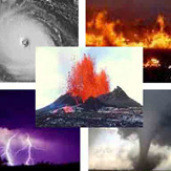
Terrorists have frequently used explosive devices as one of their most common weapons for many, many decades.
There are many “how-to” manuals available online and in books so unfortunately it’s very easy for bad people to make bombs and IEDs (Improvised Explosive Devices) in various shapes and sizes for use at events where many people are gathering like sporting events, mass protests, elections, etc.
Explosive devices are very portable, using vehicles and humans as a means of transport, and they can be easily detonated from remote locations or by suicide bombers.
Oftentimes terrorists pack bombs with ball bearings, screws, nails, nuts or other metal pieces to try to inflict as much carnage and chaos as possible.
Besides being vigilant and having good situational awareness, there are some things people can do to prepare for and respond to an explosive device or incident.
BEFORE ANY TYPE OF EXPLOSION OR INCIDENT:
Be aware & watch – Sounds simple and it is. Stay current on news, alerts and threats – but don’t obsess over them – then start making a habit of being aware of your surroundings. You don’t have to be paranoid or obvious – just make a mental note of the EXITS when you go to places and watch for things that look strange or out of place especially if you walk or drive the same route day after day.
Make a kit – Make disaster supplies kits for your home, office, locker and car. Pack things like non-perishable food, water, a battery-powered or hand-crank radio, extra flashlights and batteries, medicines (if needed), a change of clothes, comfortable shoes, some toiletries, tools, etc.
Have a plan – Check emergency plans for schools, day care and nursing home to find out where everyone goes if evacuated.
Report strange things – Again, be aware of your surroundings — watch for strange or suspicious packages, abandoned briefcases or backpacks and report suspicious activities to local authorities.
Stay current on threats - The Department of Homeland Security www.dhs.gov and Public Safety Canada www.publicsafety.gc.ca post alerts and news about national security online. And of course read or watch local news to find out what’s going on in your area.
Be ready to evacuate – Listen to authorities — if told to leave – DO it!
Learn first aid – Take a basic first aid and CPR class … or join a CERT (Community Emergency Response Team). Also consider getting USFRA's 286-page Family Preparedness & First Aid ebook
DURING AN EXPLOSION:
Don’t panic… – Stay calm and don’t stop to retrieve personal items or make phone calls – get to a safe place.
Things to watch out for:
- falling objects – if things are falling off bookshelves or from the ceiling get under a sturdy table or desk
- flying debris – many blast injuries are caused by flying glass, metal, ball bearings and other materials
- fires – stay below the smoke (crawl or walk like a duck)
- only use the stairs (don’t use elevators)
- check doors with back of hand before opening (If HOT, do NOT open .. find another exit!)
- weak structures – be careful since floors, stairs, roofs or walls might be weakened by the blast
If indoors – Stay put if building is not damaged but leave if warned of any radiation or chemical inside. Cover nose and mouth and find shelter in a building not damaged by blast and prepare to “shelter-in-place”, if necessary.
If outdoors - Cover mouth and nose with a cloth or handkerchief and take shelter in a safe building as quickly as possible!
If in a vehicle - Keep windows up, close vents, use “recirculating” air in case of airborne threats, and keep listening to radio for updates. If possible, drive away from site.
AFTER AN EXPLOSION:
If you are trapped in an area:
- light – use a flashlight – never use matches or lighters in case there are gas leaks
- be still – try to stay still so you won’t kick up dust
- breathing - cover your mouth with a piece of clothing
- make noise – tap on a pipe or wall so rescuers can hear you (shouting may cause you to inhale a lot of dust)
Rescuing others – Untrained persons should not try to rescue people who are inside a collapsed building… wait for emergency personnel to arrive – then, if they need you, they will ask.
Avoid crowds - Be aware large crowds may be targeted for another attack.
Limited services – Cellular service and towers may get overwhelmed after an incident so realize you may have limited access. And officials may cut off mobile service around an attack site to prevent further remote detonations of explosive devices.
Be ready to evacuate – Listen to authorities — if told to leave due to another threat, attack or explosion – do it!
Stay away – Avoid the scene(s) as much as possible. There will be a heavy law enforcement involvement at local, state and federal levels following a terrorist attack due to the event’s criminal nature. Also realize that health and mental health and Fire/EMS resources in the affected communities may be strained or overwhelmed.
Stay current on news – Listen to updates but again, don’t obsess over an event. Extensive media coverage can be overwhelming so try to go about your daily routines and always be aware of your surroundings.
Also review some safety information about dealing with bomb threats or suspicious packages and Dirty Bombs and learn how to order USFRA's 286-page Family Preparedness & First Aid ebook
Source: IT’S A DISASTER!

